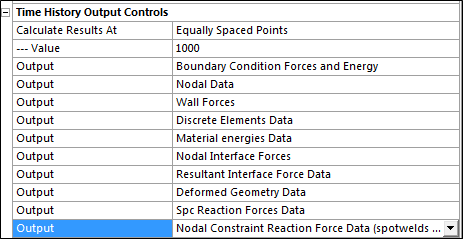The following keywords specify time-history output (ASCII format) for an explicit dynamics analysis. The time history files output are requested through Time History Output Controls section of the Analysis Settings . Up to 10 ASCII files can be requested in the GUI. The sampling time is calculated from the number of values requested and from the end time of the simulation.

The results files ( GLSTAT , BNDOUT , RCFORC , SPCFORC , MATSUM ) are always output by LS-DYNA. The sampling frequency can, however, be modified.
*DATABASE_HISTORY_NODE_SET
Controls which nodes or elements are output into the binary history file and the ASCII file NODOUT for a particular result tracker.
Card
ID1 = the ID of the component defined by the result tracker object.
*DATABASE_BNDOUT
Specifies the sampling parameters for the BNDOUT results file (stores Boundary condition forces and energy).
Card
DT = End Time divided by Value from the Time History Output Controls section of the Analysis Settings.
*DATABASE_DEFGEO
Specifies the sampling parameters for the DEFGEO results file (stores Deformed Geometry Data).
Card
DT = End Time divided by Value from the Time History Output Controls section of the Analysis Settings.
*DATABASE_DEFORC
Specifies the sampling parameters for the DEFORC results file (Discrete Elements Data).
Card
DT = End Time divided by Value from the Time History Output Controls section of the Analysis Settings.
*DATABASE_GCEOUT
Specifies the sampling parameters for the GCEOUT results file (Geometric Contact Entities).
Card
DT = End Time divided by Value from the Time History Output Controls section of the Analysis Settings.
*DATABASE_GLSTAT
Specifies the sampling parameters for the GLSTAT results file (stores general energy results).
Card
DT = End Time divided by Value from the Time History Output Controls section of the Analysis Settings.
*DATABASE_INTFORC
Specifies the sampling parameters for the JNTFORC results file (stores Joint Forces).
DT = End Time divided by Value from the Time History Output Controls section of the Analysis Settings.
*DATABASE_MATSUM
Specifies the sampling parameters for the MATSUM results file (stores general energy and velocity results as the GLSTAT file but it stores them per body. It is necessary for rigid bodies).
Card
DT = End Time divided by Value from the Time History Output Controls section of the Analysis Settings.
*DATABASE_NCFORC
Specifies the sampling parameters for the NCFORC results file (stores Nodal Interface Forces).
Card
DT = End Time divided by Value from the Time History Output Controls section of the Analysis Settings.
*DATABASE_NODOUT
Specifies the sampling parameters for the NODOUT results file (stores displacement and velocity results).
Card
DT = End Time divided by Value from the Time History Output Controls section of the Analysis Settings.
*DATABASE_RBDOUT
Specifies the sampling parameters for the RBDOUT results file (stores Rigid Body Data ).
Card
DT = End Time divided by Value from the Time History Output Controls section of the Analysis Settings.
*DATABASE_RCFORC
Specifies the sampling parameters for the RCFORC results file (stores contact forces).
Card
DT = End Time divided by Value from the Time History Output Controls section of the Analysis Settings.
*DATABASE_RWFORC
Specifies the sampling parameters for the RWFORC results file (stores Rigid Wall forces).
Card
DT = End Time divided by Value from the Time History Output Controls section of the Analysis Settings.
*DATABASE_SLEOUT
Specifies the sampling parameters for the SLEOUT results file (stores sliding interface forces).
Card
DT = End Time divided by Value from the Time History Output Controls section of the Analysis Settings.
*DATABASE_SPCFORC
Specifies the sampling parameters for the SPCFORC results file (stores reaction forces).
Card
DT = End Time divided by Value from the Time History Output Controls section of the Analysis Settings.
*DATABASE_SWFORC
Specifies the sampling parameters for the SWFORC results file (stores the spotweld and rivet forces).
Card
DT = End Time divided by Value from the Time History Output Controls section of the Analysis Settings.


